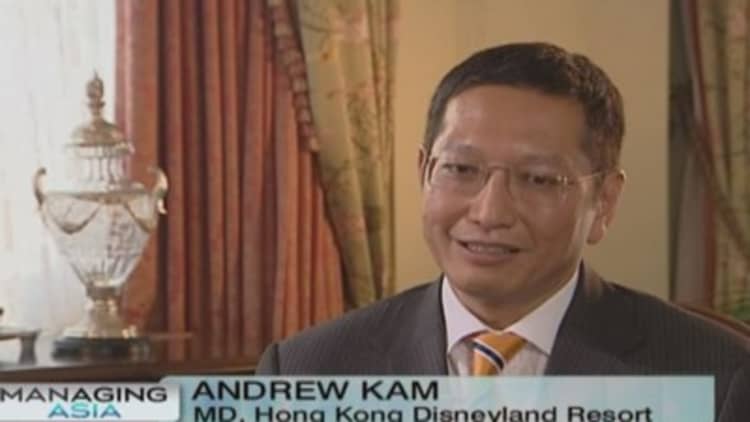
After years of disappointing results, Hong Kong Disneyland has achieved record attendance and an improved balance sheet. The key to its turnaround, according to the man who led the team at the world's smallest Disney theme park to its first profit in 2012, is expansion.
"[Expansion] is our key pillar and it set forth the solid foundation [for us] to be successful," Andrew Kam, managing director of Hong Kong Disneyland, told CNBC's "Managing Asia."
Occupying approximately 55 acres when it opened in 2005, the park has since splurged on nearly half a billion to expand its total size by about one-fourth, with new attractions like the Toy Story Land, Grizzly Gulch and Mystic Point.
Read MoreHighHo! Disneyland hikes ticket prices by up to10%
"Over the years, we've got a lot more content like the well-known Toy Story franchise. The right content can drive visitations," Kam who took over the reins in 2008 said. "Within the region, the theme park industry is still very young. With rising income, we expect growth in demand to continue."
The park – owned jointly by Hong Kong's city government and U.S.-based Walt Disney – received a record 7.4 million visitors in 2013, up 10 percent from a year earlier, largely driven by Chinese holidaymakers, who accounted for 47 percent of last year's total attendance.
Initial challenges
Being the most compact park under the Disney label, Hong Kong Disneyland struggled in its early years due to lower-than-expected attendance. In its first year of operation, visitor numbers were 400,000 short of its 5.6 million target.
Events like the 2007 global financial crisis and 2009 swine flu outbreak made addressing low attendance numbers even more daunting.
"The global financial crisis impacted Hong Kong and Asia a lot so it was a tough period but it wasn't as bad as 2009's H1N1. When you have an epidemic, basically no one wants to travel," Kam said.
Read MoreWill 'Occupy Central' hurt Hong Kong?
To counter the slump in tourists, the park focused on its domestic market.
"It worked and we did a tremendous business with our local population [as] we became a very credible alternative for people who want entertainment but are not willing to travel abroad," he added.
Keeping the magic alive
Moving ahead, the theme park will have to compete with the Shanghai Disneyland. Slated to open by the end of 2015, the new park could undermine attendance in Hong Kong but Kam is confident that his park – Disney's second resort in Asia after Tokyo – can hold its own against growing competition.
"Hong Kong has our own uniqueness. We have guests coming from both the mainland as well as Southeast Asia so our offering is very international and that is our differentiating factor," the Managing Director, who previously worked at Coca Cola and Hong Kong Tourism Board, said.
Read MoreChina to top business travel spending by 2016
New lineups are already in the pipeline. Apart from a brand new night parade called "Disney Paint the Night" in October, the park will see the addition of Disney's first ride based on a Marvelcharacter in late 2016 – the "Iron Man Experience" costing an estimated $100 million.
Hong Kong Disneyland, which celebrates its 10-year anniversary next year, is also adding a third hotel to its resort by 2017. The $550 million investment aims to add 750 rooms to its existing two hotels which have achieved 94 percent occupancy in the last few years.
Read MoreThis country tops China's favoritetravel hotspots
"Our guests told us that they stay with us [because] they want to have a complete Disney experience in Hong Kong hence we know there is a very strong demand for additional hotel inventory," Kam said.
— Reported by Christine Tan | Written by See Kit Tang




